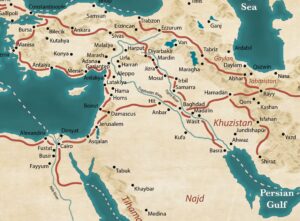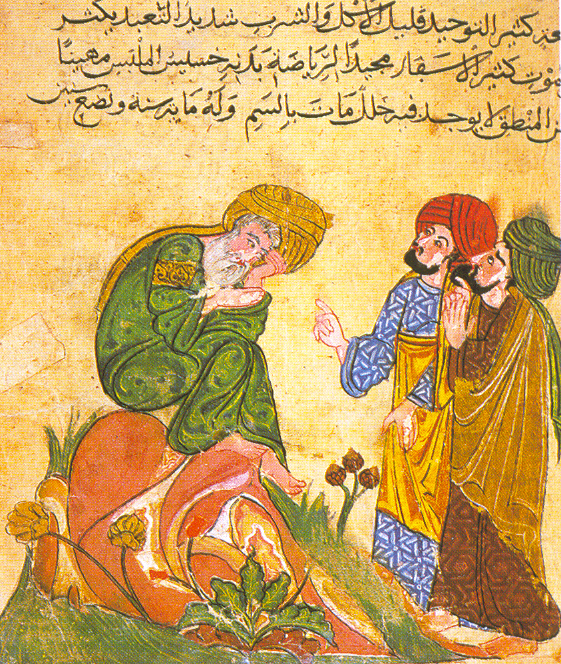The Emergence of Kufa as a Center of Learning

Emergence of Kufa as a Center of Learning
Kufa is not an ancient pre-Islamic city as many others were. It is a city that was founded and constructed by the Ṣaḥāba. It was originally founded by Saʿd b. Abī Waqqāṣ who was believed to be one of the 10 people promised Paradise in the well-known hadith on this. He led the army which conquered Iraq and he founded the city of Kufa under the command of ʿUmar. He became its governor throughout the reign of ʿUmar and part of ʿUthmān’s rule.
ʿUmar became concerned about the education and upbringing of the Muslims in the city of Kufa. It is reported that he resettled eloquent Arab tribes around the city of Kufa in order to instill and strengthen the Arabic language there. He also sent two highly respected Ṣaḥaba, ʿAmmār b. Yāsir and ʿAbd Allāh b. Masʿūd, to Kufa. He sent with them a letter to the Kufans saying:
I have sent to you ʿAmmār b. Yāsir as your leader and Ibn Masʿud as his deputy and teacher. Both are among the most distinguished Companions who fought in the Battle of Badr. They are your role models. Obey them and listen to their words. I prefer you to myself in sending you ʿAbd Allah.
Kufa was a city with a diverse population of different tribes with many disagreements. It was located in the lands of ancient Mesopotamia, modern day Iraq, which had a rich diversity of faiths and practices. Ibn Masʿūd had to lead a nascent Muslim community that was confronted with many new issues that had not be encountered during the lifetime of the Prophet Muhammad. Unlike Medina which was a homogeneous city with a relatively like-minded population, Kufa and Iraq in general was a heterogenous region where Ibn Masʿūd had to be skilled in navigating its diversity.
Ibn Masʿūd commonly used his raʾy or educated opinion derived through ijtihad to answer complex questions from the Muslim community he was appointed to lead. The report above indicates that ʿUmar b. al-Khaṭṭāb commanded the community of Kufa to adhere to Ibn Masʿūd’s religious leadership and that his judgments held religious significance.
Who was ʿAbdallah b. Masʿūd and What was His Significance?

Ibn Masʿūd was among the most highly regarded Companions of the Prophet. Historical narratives report that he was the sixth individual to convert to Islam and he kept the close company of the Prophet for almost the entirety of the Prophet’s mission. He had access to the household of the Prophet in ways that other Companions did not. Ibn Masʿūd used to serve the Prophet and his family and had the opportunity to imbibe the spirit of the Prophet’s teachings through his daily proximity to the Prophet. ʿUmar used to refer to Ibn Masʿūd as “a vessel of fiqh.”
Ibn Masʿūd had a circle of students who would record his opinions. Many of the other Companions used to also send their followers (tabiʿīn) to study with Ibn Masʿūd. Muʿādh b. Jabal is reported to have told his student to go to Iraq and study with Ibn Masʿud. Ibn Masʿūd was also close to ʿUmar b. al-Khaṭṭāb and he used to take ʿUmar’s opinions as a definitive source of knowledge; meaning that if ʿUmar had an opinion, Ibn Masʿūd would automatically follow that position. This meant that ʿUmar’s fiqh was infused into the city of Kufa without ʿUmar actually going there. In fact, the fiqh of Kufa is commonly known as the fiqh of the ʿUmari school.
Ibn Masʿūd is among the older and major Companions almost comparable to Abū Bakr and ʿUmar but he had an advantage over them in that he was not preoccupied with the politics of rule or with leading armies. His time was completely devoted to gaining knowledge. This enabled Ibn Masʿūd to pass on his knowledge in a way that many Companions were not able to. Ibn Masʿūd became known as the “Shaykh of Kufa.” It is reported that when ʿAli b. Abū Ṭālib came to Kūfa he said, “May God have mercy on Ibn Umm ʿAbd. He has filled this city with knowledge.”
ʿAlī b. Abū Ṭālib
Another one of the greatest Companions who filled the city of Kūfa with his knowledge is the son-in-law of the Prophet and fourth caliph, ʿAlī. ʿAlī’s closeness to the Prophet and his piety is mentioned in numerous hadith reports. The Prophet also trusted ʿAlī’s judgment enough to send him as a judge to Yemen during the Prophet’s lifetime.
Ibn Masrūq is quoted to have said that “The source of knowledge returned to three people: a scholar in Medina and a scholar of Iraq and scholar of Sham.” At his time the scholar of Medina was ʿAlī. The scholar of Sham was Abū Dardāʾ and the scholar of Iraq was Ibn Masʿūd. When ʿAlī became caliph, he made Kufa his capital city and settled there along with many members of the family of the Prophet. The city of Kufa becomes doubly enriched when the teachings of Ibn Masʿūd and the ʿUmari school merge with the knowledge of ʿAlī and the wisdom he exhibited throughout his leadership.
When Kufa became the capital of the Muslim community under the caliphate of ʿAlī, it is reported that 1500 Ṣaḥāba (Companions) took up residence in Kufa. Among them were 70 from the Companions who participated in the Battle of Badr. Hence, we see that during the period of ʿAlī’s leadership, many of the prominent are relocated to Kufa to be close to ʿAlī. This does not even count the even more numerous numbers of Ṣaḥaba and their followers who would have traveled through Kufa without settling there.
Thus Kufa develops into a rich center of the tradition of the Prophet as inherited by the Ṣaḥāba and their followers that parallels and at times rivals Medina. Medina adopted an approach whereby they attempted to preserve the practices of the early community of the Prophet through ʿamal ahl al-Maḍina and the hadith tradition they wrote down. Whereas the spirit of Kufa was one in which Muslims tried to preserve the essence and spirit of the Prophet’s teachings that had to take many different outward forms in a diverse and heterogenous city like Kufa.
The Muslims of Kufa had to be versatile and know how to make educated opinions on new issues that did not arise in Medina. This openness to ijtihād and following the spirit of the Prophet’s teaching in the form of the farʿ to derive the aṣl differed from the religiouses practices of Medina and Syria. This is where a division between the followers of raʾy or judgment as opposed to the emulation of hadith develops. The Kufans were the ahl al-raʾy and the Medinans were the ahl al-ḥadīth. However, in examining the fiqh in Iraq it is important to note that this was not an independent group of people who formulated their own methods of raʾy. Kūfa was a city full of Ṣaḥāba who established a rich tradition of ijtihād based on what they learned from the Prophet himself.
Followers (tābiʿīn) from the City of Kufa

ʿAlqama b. Qays al-Nakhaʿī
- ʿAlqama was from the closest students of Ibn Masʿūd. Ibn Masʿūd is reported to have said I did not know anything except ʿAlqama came to know it. Thus, this tābiʿī kept such close company of Ibn Masʿūd until he himself became a representative and transmitter of the tradition of Ibn Masʿūd himself. Even many of the younger Ṣaḥāba used to ask him questions because he became Ibn Masʿūd.
- ʿAlqama is also known to have traveled to Medina and where he learned from ʿUmar, Zayd b. Thābit, and ʿĀʾisha and to Syria where he took knowledge from Abū Dardāʾ. He became known as the shaykh of the tābiʿīn.
Shurayḥ b. al-Ḥārith
- Shurayḥ was also from among the peers of ʿAlqama.
- He became a judge in Kufa and was known for the correspondence he received from ʿUmar stating, “If nobody before you spoke in these matters, exert your opinion or stay back.”
- He was an older tābiʿī and became extremely learned. He was a judge for sixty years. This meant that his tenure as a judge in Kufa coincided with the caliphates of ʿUmar, ʿUthmān, and ʿAlī.
- He had decades of experience judging new issues that appeared in the far away land of Iraq. ʿAlī is reported to have said to him, you are the best of judges from among the Arabs.
There were countless other tābiʿīn in the city of Kufa. These three were among the most prominent ones leading to the emergence of Imam Abū Ḥanīfa.
Followers of the followers (tābīʿ tābiʿīn)
Ibrāhīm al-Nakhāʿī
- He had a sharp intellect and keen capacity for legal reasoning while also being a prominent scholar of hadith (muḥaddith).
- The combination of his extensive knowledge of hadith with his exceptional acumen in legal reasoning made him unsurpassed in Kufa as a scholar of Islamic law.
- Aʿmash another great hadith scholar of Kūfa said, “I never presented anything to Ibrāhīm except that I found he already had something of it.”
- Aʿmash also said, “He was a meticulous analyst of hadiths.” If a hadith came [to him] he can scrutinize it, reason with it, compare it to other hadiths. He could feel the hadith. Ibn Jubayy the great student of Ibn ʿAbbās once said, “Do you ask me for fatwas and you have Ibrāhīm?”
- He was also asked once, “Have you heard every fatwa you give from the people before you?” He said, “No I did not.” Then how can you give a fatwa and nobody before you said it? He said, “I heard what I heard. And it came to me what I had not heard.” So what he is saying is that the problems I am solving are not made up on my own. It is based on the knowledge and training he received before him from the company of the tābiʿīn he kept. He is a transmitter of the prophetic tradition of legal reasoning and his knowledge is based on what he received from those who came before him. He was a problem solver following the path of the scholars before him.
- He used to also say, “No religious reasoning is good without hadiths. And no hadiths are good without reasoning.” He meant that fiqh had to be strong in both hadith and reasoning.
Ḥammad b. Sulaymān
- Ḥammād b. Sulaymān kept the close company of Ibrāhīm al-Nakhaʿī’s and became his most prominent student.
- He also took hadiths from other prominent scholars of his time such as Anas b. Mālik, Ḥasan al-Baṣrī, and Saʿīd b. al-Musayyab. Ḥammād b. Sulaymān eventually succeeded Ibrahīm al-Nakhaʿī and became the head of his school after his death.
- Ḥammād b. Sulaymān came back once from Ḥajj and said, “I met ʿAṭāʾ and Ṭāwūṣ (ie the students of Ibn ʿAbbās) and he said your children have a better understanding of fiqh.” He is showing his pride in the religious reasoning of the city of Kufa. This also demonstrates the rivalry that was existent among the centers of learning and this rivalry was healthy for their development.
Kufa also excelled as a center for the study of Arabic grammar. In the Hijāz there were some corruptions to the Arabic language creeping in and yet they did not have a formal grammar to confront this trend. The establishment of Arabic grammar was in Kufa and then Baṣra. Even though Kufa was not a native Arabic speaking land. The Arabic language was established in this city through the settlement of Arab tribes and the development of the sciences of grammar in Kufa by mostly non-Arabs. As a result of this trend, grammar became rooted in one of two schools; either the Kufan or the Basran.
Kufa also became a center in the study of the Qur’an. Of the 7 canonical readings, three of them were rooted in Kufa. Thus, Kufa became a peer to Medina and Mecca and even surpassed them in many fields of study.
Imam Nuʿmān b. Thābit Abū Ḥanīfa
Among the four Imams he is the oldest of them. He is also the only one who has the rank of being among the tābiʿīn because according to some reports he met Anas b. Mālik before he died. So he has an advantage in being older and closer. He is a non-Arab by blood. His grandfather was Zūtī from Afghanistan Kabūl. Zūtī moved to Kufa and kept the company of ʿAlī. His son Thābit also kept the company of ʿAlī. It is said that ʿAlī prayed for him and his children and that the success of Imam Abū Ḥanīfa is the result of the duʿa of Imām ʿAlī.
He kept the close company of Ḥammād b. Sulaymān who was the closest student of Ibrāhīm al-Nakhaʿī. Ibrāhīm al-Nakhaʿī was ʿAlqama who was Ibn Masʿūd. He kept his intimate and close company for eighteen years.



